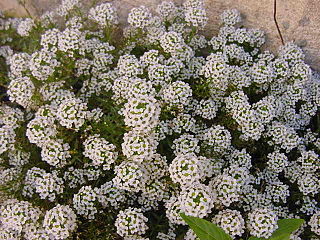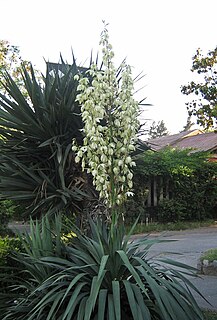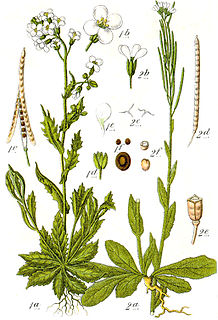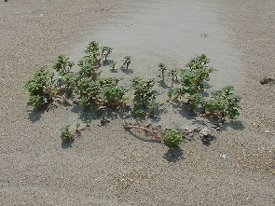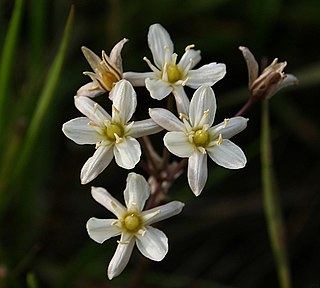This article includes a list of references, but its sources remain unclear because it has insufficient inline citations .(January 2019) (Learn how and when to remove this template message) |
| Cakile | |
|---|---|
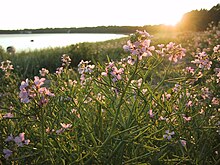 | |
| Cakile maritima | |
| Scientific classification | |
| Kingdom: | Plantae |
| Clade: | Angiosperms |
| Clade: | Eudicots |
| Clade: | Rosids |
| Order: | Brassicales |
| Family: | Brassicaceae |
| Genus: | Cakile Mill. |
Cakile is a genus within the flowering plant family Brassicaceae. Species in this genus are commonly known as searockets, though this name on its own is applied particularly to whatever member of the species is native or most common in the region concerned, the European searocket Cakile maritima in Europe, and the American searocket C. edentula in North America. The genus is native to Europe, Asia and North America, but the European searocket has been introduced into North America and has spread widely on both east and west coasts; in many places it is replacing the native C. edentula, and is regarded as an undesirable invasive species.
A genus is a taxonomic rank used in the biological classification of living and fossil organisms, as well as viruses, in biology. In the hierarchy of biological classification, genus comes above species and below family. In binomial nomenclature, the genus name forms the first part of the binomial species name for each species within the genus.

Brassicaceae or Cruciferae is a medium-sized and economically important family of flowering plants commonly known as the mustards, the crucifers, or the cabbage family. Most are herbaceous plants, some shrubs, with simple, although sometimes deeply incised, alternatingly set leaves without stipules or in leaf rosettes, with terminal inflorescences without bracts, containing flowers with four free sepals, four free alternating petals, two short and four longer free stamens, and a fruit with seeds in rows, divided by a thin wall.

Europe is a continent located entirely in the Northern Hemisphere and mostly in the Eastern Hemisphere. It is bordered by the Arctic Ocean to the north, the Atlantic Ocean to the west and the Mediterranean Sea to the south. It comprises the westernmost part of Eurasia.
Cakile species grow as annual plants with an erect or decumbent stem. The common species in Europe and North America grow close to the coast, often in dunes. Their leaves are fleshy. Flowers are typically pale mauve to white, with petals about 1 cm in length. Each fruit has two sections, one that remains attached to the adult, and the other which that falls off for dispersal by wind or water. [1]
They are rather similar to those of the wild radish (also in family Brassicaceae) which is found in the same regions, and careful attention to the leaves and stems is needed to tell the two plants apart.
As of January 2019 [update] , Kew's Plants of the World Online accepts seven species: [2]

Kew is a district in the London Borough of Richmond upon Thames, 1.5 miles (2.4 km) north-east of Richmond and 7.1 miles (11.4 km) west by south-west of Charing Cross; its population at the 2011 Census was 11,436.
Plants of the World Online is an online database published by the Royal Botanic Gardens, Kew. It was launched in March 2017 with the ultimate aim being "to enable users to access information on all the world's known seed-bearing plants by 2020". The initial focus was on tropical African Floras, particularly Flora Zambesiaca, Flora of West Tropical Africa and Flora of Tropical East Africa.
- Cakile arabica Velen.
- Cakile arctica Pobed.
- Cakile constricta Rodman
- Cakile edentula (Bigelow) Hook.
- Cakile geniculata (B.L.Rob.) Millsp.
- Cakile lanceolata (Willd.) O.E.Schulz
- Cakile maritima Scop.

Cakile edentula, the American searocket, is a species of the flowering Cakile plant. This plant is native to North America.

Cakile maritima, is a common plant in the mustard family. It is widespread in Europe, North Africa and western Asia, especially on coastlines. It can now be found in many other areas of the world where it has been introduced. It is an inhabitant of the west and east coasts of North America, where it has the potential to become a noxious weed. This is an annual plant which grows in clumps or mounds in the sand on beaches and bluffs. The shiny leaves are fleshy, green and tinted with purple or magenta, and long-lobed. It has white to light purple flowers and sculpted, segmented, corky brown fruits one to three centimeters long. The fruits float and are water-dispersed.





